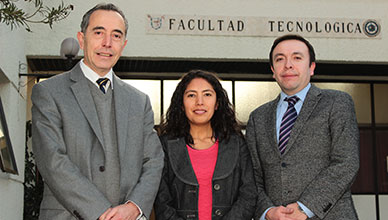- The study in collaboration with Universidad Pontificia Bolivariana of Colombia and the Colegio de la Frontera Norte of Mexico intends to identify in the corresponding countries the barriers that companies face at incorporating innovation as part of their organizational culture.
- In a letter recently addressed to President Juan Manuel Zolezzi, the Organization of American States (OAS) highlighted the work of the research team of Universidad de Santiago that participated in the Chilean chapter, for the valuable contribution of the results obtained to identify good practices and opportunities for collaboration.
An interesting work to identify the variables that make difficult the incorporation of innovation to organizations was developed last year by Universidad Pontificia Bolivariana de Colombia (UPB), together with a research team of the Technological Faculty of Universidad de Santiago and the Economic Studies Department of the Colegio de la Frontera Norte of Mexico.
The Chief of the Section of Competitiveness, Innovation and Technology, César Pargas, on behalf of the OAS’ Department of Economic and Social Development, which had reviewed the results of the study, sent a letter to the President of Universidad de Santiago, highlighting the Chilean chapter’s work developed at the Technological Faculty by academics Julio González, Antonio Gutiérrez and Alex Ramos Alarcón and graduate students Natalia Romero and Luis García.
The letter said that the results obtained after the study “Barriers to Innovation- Integral Coefficient of Innovation U” (Barreras para la Innovación-Coeficiente integral de innovación U”) were considered “very satisfactory” and “an important contribution”. The fact that it was conducted in three countries “adds value to it” and it can be used and compared by innovation-oriented work teams “to identify good practices and opportunities for collaboration.”
Identifying barriers
The study “Barriers to Innovation- Integral Coefficient of Innovation U” includes a method developed by the Colombian research team of UPB that identifies 18 factors that make difficult the incorporation of innovation to companies. The variables are related to the lack of trained staff, lack of motivation, and strategies to motivate the staff, among others.”
The UPB’s hypothesis was applied to more than 500 companies and then, thanks to the permanent contact between the Colombian academics John Wilder and Bibiana Arango and the team of Universidad de Santiago, the method was transferred to be tested in Chile.
Going beyond the method designed
“We conducted a study in 17 Chilean companies applying this method. But we went beyond. Besides adding three more variables, we proposed developing this tool with strategies and actions to finish with each of the 21 barriers and facilitate the incorporation of innovation in organizations. We made this contribution and we have continued moving forward with the study,” Julio González, Director of the Department of General Technologies of the Technological Faculty.
“We generated strategies to reduce the impact of the variables, because the study in Colombia only determined how high the barrier was. We proposed observable, controllable, measurable and relevant strategies and actions,” Antonio Gutiérrez, academic at the Department of Industrial Technologies, said. He added that the coefficient U (a concept from the thermodynamics field) is different in each case, depending on the reality of each company.
Julio González said that this stage developed in Chile is focused on the organizational aspect. The tool is intended for decision-makers at companies and it is “a very good self-diagnosis instrument for work teams.”
“Innovating is a human act; however, its implementation in organizations involves different stages and processes. This management tool intends to improve the innovation adoption process as part of a permanent culture,” Antonio Gutiérrez added.
More information about the progress in this organizational management tool will be published by the Faculty in an e-book that will show the experiences in Mexico, Colombia and Chile and the details will be presented in the Third International Conference on Technological Management and Organization (Tercer Encuentro Internacional de Organización y Gestión Tecnológica, in Spanish), scheduled for November.
Translated by Marcela Contreras



